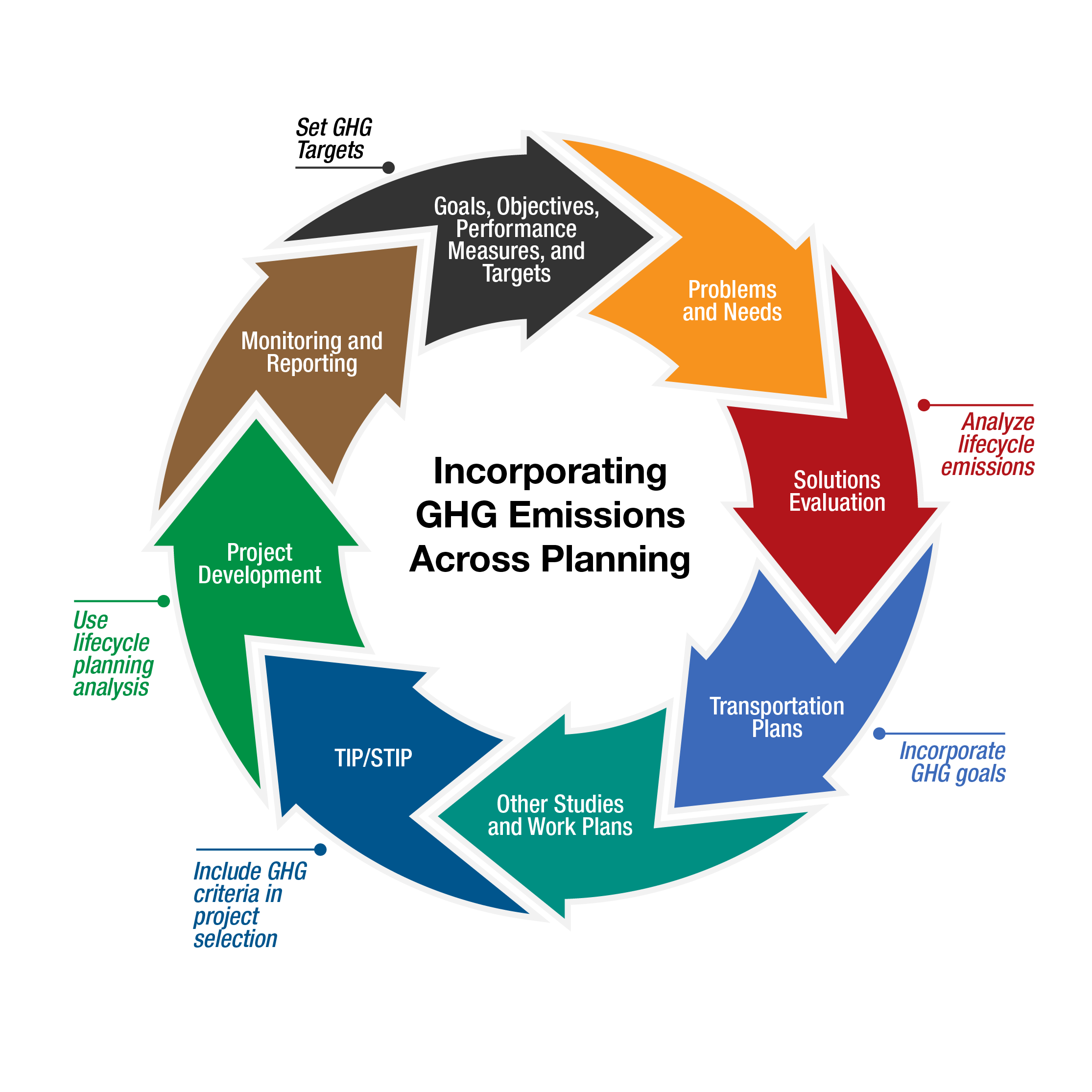
Reducing Greenhouse Gas Emissions through Transportation Planning
Increased greenhouse gas (GHG) levels can lead to climate change and extreme weather, which affects both people and our investments in infrastructure. The United States has set an economy-wide target of reducing GHG emissions by at least 50 percent below 2005 levels by 2030. As the Nation’s largest generator of GHG emissions, the transportation sector can significantly address GHG emissions and their impact on quality of life.
To help meet the target, FHWA included integrating GHG assessment and reduction targets in transportation planning as part of Every Day Counts round seven (EDC-7). This initiative addresses vehicle tailpipe and life-cycle emissions. Life-cycle emissions represent carbon emissions released through building materials, including mineral extraction, manufacturing, transportation, construction, and disposal.
“We’re inheriting 100 years of infrastructure that has been focused on moving people around cities, States, and the country that is very carbon intensive,” said David D’Onofrio, EDC-7 integrating GHG team co-lead. “It’s a challenge, but transportation planning can retrofit that infrastructure and play a unique role in addressing GHG emissions in the future.”
Watch this spotlight video to learn more about this EDC-7 innovation.
Credit: FHWAThe planning process for agencies such as State departments of transportation (DOTs) and metropolitan planning organizations (MPOs) takes place over multiple years and lays the foundation for how funds will be invested in transportation infrastructure. By integrating GHG into the planning process and making it one of the key decision factors for infrastructure investments, agencies can curb future emissions.
For example, expanding public transit networks, building more bike lanes, and creating pedestrian-friendly infrastructure could help reduce reliance on cars. Transportation planners can also promote the use of electric vehicles and expand the availability of charging infrastructure to help reduce tailpipe emissions. Another consideration is land use. The need to drive is often determined by the fact that housing and where people work, shop, play, or go to school may be far apart. By further integrating land use and transportation planning, planners can help reduce the need to drive.
Incorporating GHG assessment and reduction targets into the transportation planning process can seem overwhelming, but the EDC-7 initiative is designed to make it easier by linking stakeholders with information on when and how to incorporate GHG considerations. Even those who may be halfway through the long process of creating a transportation improvement plan can benefit. “We want to meet agencies where they are in the process and provide useful information for whichever stage they are at on the planning wheel,” said D’Onofrio.

This graphic illustrates typical steps an agency completes during the transportation planning process. Examples are included on the outside of the planning wheel to show how GHG emissions can be considered.
Credit: FHWAAgency Examples
DOTs and MPOs in several States are taking action to integrate best practices related to GHG assessment and reduction into the transportation planning process.
Oregon is one of several States taking action to integrate GHG policy and analysis into planning and project development. “I think we need to consider how our investments affect how people travel,” said Oregon DOT Policy, Data, and Analysis Administrator Amanda Pietz. “We must make the connection between end users and whether emissions will increase or decrease due to our investment.”
The Minnesota DOT developed the Minnesota Infrastructure Carbon Estimator tool to help transportation planners, engineers, and decision-makers make informed choices that promote lower-carbon infrastructure development. The tool allows users to assess the carbon footprint of various aspects of transportation projects, including construction materials, energy consumption, and vehicle operations.
In 2008, California adopted the Sustainable Communities and Climate Protection Act, Senate Bill 375, which sets regional GHG reduction targets for MPOs. The law requires MPOs to align land use planning and transportation investments to reduce the need for long car trips, promote transit-oriented development, and work with local governments to ensure housing is available near transit and employment centers.
The EDC-7 integrating GHG initiative will help transfer knowledge on tools and strategies currently in use among agencies so more agencies can act now to help decrease future emissions.
—MORE INFORMATION
Visit the EDC-7 Integrating GHG Assessment and Reduction Targets in Transportation Planning webpage.
Subscribe to the Integrating GHG Assessment and Reduction Targets in Transportation Planning e-bulletin.
Contact David D’Onofrio in the FHWA Office of Natural Environment or Jim Thorne in the FHWA Office of Planning for more information.
Disclaimer: The U.S. Government does not endorse products or manufacturers. Trademarks or manufacturers’ names appear in this document only because they are considered essential to the objective of the document. They are included for informational purposes only and are not intended to reflect a preference, approval, or endorsement of any one product or entity.
Except for the statutes and regulations cited, the contents of this document do not have the force and effect of law and are not meant to bind the States or the public in any way. This document is intended only to provide information regarding existing requirements under the law or agency policies.
Recommended Citation: U.S. Department of Transportation, Federal Highway Administration - Washington, DC (2023) Innovator Newsletter, November/December 2023, Volume 17 (99). https://doi.org/10.21949/1521764
- Cover
- Alaska Expands Reach of UAS in Remote Locations and Extreme Conditions
- Reducing Greenhouse Gas Emissions through Transportation Planning
- Giving First Responders the Green Light
- EDC Legacy—Expanding the Reach of Public Engagement
- States Innovate
- STIC Showcase Features Homegrown Innovations
- Applications Open for AID Demonstration Grants
- About Innovator



